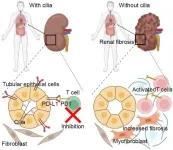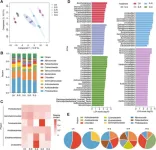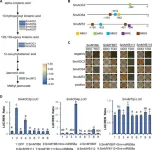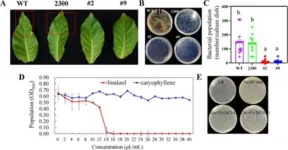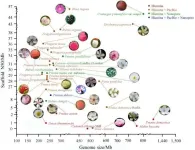(Press-News.org) About The Study: Bariatric metabolic surgery was associated with greater reduced mortality compared with first-generation glucagon-like peptide-1 receptor agonists (GLP-1RAs) among individuals with a diabetes duration of 10 years or less, mediated via greater weight loss in this cohort study. No differences in the risk for mortality were observed between the treatment modalities among individuals with a longer duration of diabetes, nor in the occurrence of nonfatal major adverse cardiovascular events among all patients.
Corresponding Author: To contact the corresponding author, Orna Reges, Ph.D., email orna.reges@gmail.com.
To access the embargoed study: Visit our For The Media website at this link https://media.jamanetwork.com/
(doi:10.1001/jamanetworkopen.2024.15392)
Editor’s Note: Please see the article for additional information, including other authors, author contributions and affiliations, conflict of interest and financial disclosures, and funding and support.
# # #
Embed this link to provide your readers free access to the full-text article This link will be live at the embargo time http://jamanetwork.com/journals/jamanetworkopen/fullarticle/10.1001/jamanetworkopen.2024.15392?utm_source=For_The_Media&utm_medium=referral&utm_campaign=ftm_links&utm_term=060724
About JAMA Network Open: JAMA Network Open is an online-only open access general medical journal from the JAMA Network. On weekdays, the journal publishes peer-reviewed clinical research and commentary in more than 40 medical and health subject areas. Every article is free online from the day of publication.
END
Bariatric metabolic surgery vs glucagon-like peptide-1 receptor agonists and mortality
JAMA Network Open
2024-06-07
ELSE PRESS RELEASES FROM THIS DATE:
Primary cilia restrict autoinflammation by mediating PD-L1 expression
2024-06-07
Ciliopathies are multisystem disorders characterized by the dysfunction of motile and/or non-motile cilia, which show common clinical manifestations of ciliopathies include retinal degeneration, mental retardation, renal abnormality, obesity, and skeletal dysplasia. Fibrosis of vital organs, characterized by the extensive deposition of extracellular matrix components, represents another complication frequently observed in patients and animal models of ciliopathies. However, the precise mechanism that connects ciliary defects to fibrosis remains largely elusive.
The recent study led by Dr. Min Liu (Haihe Laboratory of Cell Ecosystem) and Dr. Yunfan Yang (Shandong University) showed ...
Roots of resistance: unveiling the soil-saving secrets of grafting
2024-06-07
Grafting, an age-old horticultural technique, has been revealed as a powerful tool against soil-borne diseases like crown gall. New research uncovers how the composition of root exudates changes when plants are grafted onto resistant rootstocks, creating a defensive mechanism that reduces the prevalence of pathogenic Agrobacterium.
Crown gall disease, a destructive plant ailment caused by Agrobacterium, has long plagued agriculture, leading to significant crop losses. Traditional control methods have proven inadequate, highlighting an urgent need for innovative solutions. Given the pervasive impact of this disease and the limitations ...
Insilico Medicine Founder and CEO Alex Zhavoronkov, PhD talks about AI and robotics in healthcare breakthroughs in following conferences
2024-06-07
Alex Zhavoronkov, PhD, founder and co-CEO of Insilico Medicine (“Insilico”), a clinical-stage generative artificial intelligence (AI)-driven drug discovery company, will be attending a series of meetings in the following week, where he will be discussing bioscience innovations powered by AI and robotics.
More information about the events is listed as follows:
[1] London Tech Week 2024
Fireside Chat: The Forefront of AI Innovation in Health Tech
Time: Monday, 10th June 15:55 - 16:15 (UK time)
Location: London Olympia, Main Stage
London Tech Week is the global tech ecosystem aiming to accelerate the infinite cycle of tech innovation, which brings together the innovators ...
New: Classification Criteria for Hand OA
2024-06-07
Hand osteoarthritis mainly affects the distal interphalangeal, proximal interphalangeal, and thumb base joints,1 leading to joint pain, aching, and stiffness. Criteria developed by the American College of Rheumatology (ACR) in 1990 are useful, but they cannot distinguish between interphalangeal or thumb base disease, and this is important since these two phenotypes may require different treatment strategies.
To address this, EULAR and a team of leading experts in the field set out to develop new classification criteria sets that include radiographic features. Early phases of the project used observational data to identify self-reported, ...
Perturbations simplify the study of “super photons”
2024-06-07
Thousands of particles of light can merge into a type of “super photon” under suitable conditions. Physicists call such a state a photon Bose-Einstein condensate. Researchers at the University of Bonn have now shown that this exotic quantum state obeys a fundamental theorem of physics. This finding now allows one to measure properties of photon Bose-Einstein condensates which are usually difficult to access. The study has been published in the journal Nature Communications.
If many atoms are cooled to a very low temperature confined in a small volume, they can become indistinguishable and behave like a single “super particle.” Physicists also call this ...
Decoding salvia miltiorrhiza: a molecular approach to boosting bioactive compounds
2024-06-07
Salvia miltiorrhiza, known as Danshen, is widely used in traditional Chinese medicine for treating cardiovascular diseases, cancer, and Alzheimer's disease. The medicinal properties of Danshen are primarily attributed to its two major bioactive compounds: tanshinones and phenolic acids. Despite their importance, the genetic and regulatory mechanisms underlying their biosynthesis remain poorly understood. Based on these challenges, there is a pressing need for in-depth research to uncover the molecular pathways involved in the production of these ...
Digital babies created to improve infant healthcare
2024-06-07
Researchers at University of Galway have created digital babies to better understand infants’ health in their critical first 180 days of life.
The team created 360 advanced computer models that simulate the unique metabolic processes of each baby.
The digital babies are the first sex-specific computational whole-body models representing newborn and infant metabolism with 26 organs, six cell types, and more than 80,000 metabolic reactions.
Real-life data from 10,000 newborns, including sex, birth weight and metabolite concentrations, enabled the creation and validation ...
Lavender's secret: genetic regulator boosts plant health and fragrance output
2024-06-07
A groundbreaking study has identified a gene that plays a dual role in enhancing both the aromatic compounds and disease resistance in lavender plants. The research uncovers how the LaMYC7 gene positively regulates the biosynthesis of linalool and caryophyllene, key for lavender's scent and its resistance to common plant pathogens.
Plants face various environmental pressures, including biotic stressors like pathogens and abiotic stressors such as extreme temperatures. Among biotic stressors, Pseudomonas syringae significantly threatens plant health worldwide. Terpenoids, including linalool and caryophyllene, play crucial roles in plant ...
How $4 billion funded the unprecedented COVID-19 pandemic response
2024-06-07
New University of Virginia School of Medicine research is shedding light on how federal funding helped scientists understand the COVID-19 virus, develop new treatments and deploy lifesaving vaccines in record time.
The UVA Health researchers used advanced “machine learning” – a form of artificial intelligence – to analyze the thousands of scientific publications that resulted from the National Institutes of Health’s deployment of more than $4 billion to combat the pandemic. This analysis allowed the researchers to categorize the types ...
Advances in omics research of rosaceae
2024-06-07
A research team has provided a comprehensive overview of the applications of omics technologies in Rosaceae plants. The study highlights significant advancements in genome sequencing, transcriptome, proteomics, and metabolomics, shedding light on the genetic regulatory mechanisms underlying crucial traits such as flower color, fragrance, stress tolerance, and fruit quality. This research is invaluable for molecular breeding and improving economic traits in Rosaceae plants, potentially leading to the rapid cultivation of new varieties and germplasm.
The Rosaceae family, with its diverse species and economic importance, is a focus ...
LAST 30 PRESS RELEASES:
Anthropologists offer new evidence of bipedalism in long-debated fossil discovery
Safer receipt paper from wood
Dosage-sensitive genes suggest no whole-genome duplications in ancestral angiosperm
First ancient human herpesvirus genomes document their deep history with humans
Why Some Bacteria Survive Antibiotics and How to Stop Them - New study reveals that bacteria can survive antibiotic treatment through two fundamentally different “shutdown modes”
UCLA study links scar healing to dangerous placenta condition
CHANGE-seq-BE finds off-target changes in the genome from base editors
The Journal of Nuclear Medicine Ahead-of-Print Tip Sheet: January 2, 2026
Delayed or absent first dose of measles, mumps, and rubella vaccination
Trends in US preterm birth rates by household income and race and ethnicity
Study identifies potential biomarker linked to progression and brain inflammation in multiple sclerosis
Many mothers in Norway do not show up for postnatal check-ups
Researchers want to find out why quick clay is so unstable
Superradiant spins show teamwork at the quantum scale
Cleveland Clinic Research links tumor bacteria to immunotherapy resistance in head and neck cancer
First Editorial of 2026: Resisting AI slop
Joint ground- and space-based observations reveal Saturn-mass rogue planet
Inheritable genetic variant offers protection against blood cancer risk and progression
Pigs settled Pacific islands alongside early human voyagers
A Coral reef’s daily pulse reshapes microbes in surrounding waters
EAST Tokamak experiments exceed plasma density limit, offering new approach to fusion ignition
Groundbreaking discovery reveals Africa’s oldest cremation pyre and complex ritual practices
First breathing ‘lung-on-chip’ developed using genetically identical cells
How people moved pigs across the Pacific
Interaction of climate change and human activity and its impact on plant diversity in Qinghai-Tibet plateau
From addressing uncertainty to national strategy: an interpretation of Professor Lim Siong Guan’s views
Clinical trials on AI language model use in digestive healthcare
Scientists improve robotic visual–inertial trajectory localization accuracy using cross-modal interaction and selection techniques
Correlation between cancer cachexia and immune-related adverse events in HCC
Human adipose tissue: a new source for functional organoids
[Press-News.org] Bariatric metabolic surgery vs glucagon-like peptide-1 receptor agonists and mortalityJAMA Network Open
